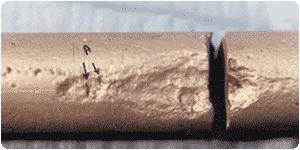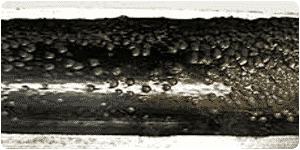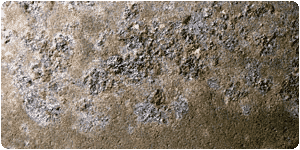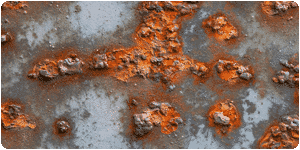Types Of Corrosion
While there are a number of forms or types of corrosion, it is rare that a corroding structure or component will suffer from only one. While some forms of corrosion may be unique they are all interrelated.
The 4 Elements Of Corrosion
Before corrosion can take place four conditions must be satisfied:
- The presence of a corrodible metal or alloy (anode)
- The presence of a dissimilar conductive material that has a lesser tendency to corrode (cathode)
- The presence of an electrolyte, fresh or salt water
- Electrical contact between the anode and the cathode
The elimination of any of the above conditions will halt the corrosion process!

Hydrogen Induced Cracking
Results in the brittle failure of otherwise ductile or malleable materials when exposed to an environment where hydrogen can enter the metal. This is a common problem in processes or conditions involving wet hydrogen sulfide such as in oil fields.

Erosion or Flow Corrosion
Caused by the corrosive fluid flowing through an unprotected metal surface such as a pipe.

Pitting Corrosion
A deep, focused attack that can cause rapid penetration of the metal. Pitting is one of the most destructive forms of corrosion. It is also difficult to detect because of the generally small size of the pit or hole.

Intergranular Corrosion
The preferential attack at, or adjacent to, the grain boundaries of a metal. Intergranular corrosion causes the alloy to disintegrate and loses its strength. Exfoliation corrosion is visible evidence of intergranular corrosion and most often seen on extruded sections where grain thickness is less than in rolled form.

Microbial Corrosion
Caused by specific types of microbes or bacteria’s waste in an otherwise benign environment which can lead to corrosion.
Stress Corrosion Cracking
Occurs in metals exposed to repetitive high tensile stresses and the presents of a corrosive medium such as salt water causing fine cracks to develop through the metal.
Corrosion Fatigue
Caused by the combined action of a repeated cyclic tensile stresses such as aircraft landings and a corrosive environment such as sea water.
Uniform Corrosion
The most common form of corrosion. Found in ferrous metals that are unprotected by a surface coating corrosion preventive compound. Corrosion is in the form of a uniform layer of “rust” on the surface where the metal becomes thinner and will eventually fail. This is the most common type of corrosion, and from a technical point, the best understood.
Fretting Corrosion
Defined as metal deterioration caused by repetitive slip or movement at the point where two surfaces come in to contact and move against each other. The two surfaces were not intended to move in that fashion.
Crevice Corrosion
A microscopic crack or crevice where materials meet, either metal-to-metal or metal-to-nonmetal materials such as a gasket, that is filled with moisture which then becomes de-oxygenated and undisturbed by the surrounding environment allowing corrosion to take place.
Selective Leaching or De-alloying
A corrosion process in which one constituent of an alloy is removed preferentially, leaving an altered residual structure.
Galvanic Corrosion
Occurs because of the potential differences between two or more different metals when they are in contact and exposed to an electrolyte, such as dissimilar metals in direct contact with each other and with salt water. Corrosion occurs at the anode. Any mechanical damage such as scratches on anodized aluminum and Galvanic corrosion will quickly eat through the metal.
Stray Voltage Corrosion
Very similar to galvanic corrosion however the current amplitude is generally higher than that produced in galvanic corrosion and the corrosion much more rapid.
Exfoliation corrosion
Exfoliation corrosion is a severe type of intergranular corrosion that raises surface grains from metal by forming corrosion products at grain boundaries under the surface.
Further information
We can provide you with a Material Safety Data Sheet, independent laboratory reports, product samples or technical assistance. For more information or advice please contact us by telephone on +44 (0) 20 8281 6370 or use our contact form.
CORR-EX corrosion protection products are supplied and supported by EnviroTech Europe Ltd. Manufactured in the United Kingdom and available on short delivery times through our dedicated team of distributors in Europe and the Middle East.
Share this page:
Types Of Corrosion
While there are a number of forms or types of corrosion, it is rare that a corroding structure or component will suffer from only one. While some forms of corrosion may be unique they are all interrelated.
The 4 Elements Of Corrosion
Before corrosion can take place four conditions must be satisfied:
- The presence of a corrodible metal or alloy (anode)
- The presence of a dissimilar conductive material that has a lesser tendency to corrode (cathode)
- The presence of an electrolyte, fresh or salt water
- Electrical contact between the anode and the cathode
The elimination of any of the above conditions will halt the corrosion process!

Hydrogen Induced Cracking
Results in the brittle failure of otherwise ductile or malleable materials when exposed to an environment where hydrogen can enter the metal. This is a common problem in processes or conditions involving wet hydrogen sulfide such as in oil fields.

Erosion or Flow Corrosion
Caused by the corrosive fluid flowing through an unprotected metal surface such as a pipe.

Pitting Corrosion
A deep, focused attack that can cause rapid penetration of the metal. Pitting is one of the most destructive forms of corrosion. It is also difficult to detect because of the generally small size of the pit or hole.

Intergranular Corrosion
The preferential attack at, or adjacent to, the grain boundaries of a metal. Intergranular corrosion causes the alloy to disintegrate and loses its strength. Exfoliation corrosion is visible evidence of intergranular corrosion and most often seen on extruded sections where grain thickness is less than in rolled form.

Microbial Corrosion
Caused by specific types of microbes or bacteria’s waste in an otherwise benign environment which can lead to corrosion.
Stress Corrosion Cracking
Occurs in metals exposed to repetitive high tensile stresses and the presents of a corrosive medium such as salt water causing fine cracks to develop through the metal.
Corrosion Fatigue
Caused by the combined action of a repeated cyclic tensile stresses such as aircraft landings and a corrosive environment such as sea water.
Uniform Corrosion
The most common form of corrosion. Found in ferrous metals that are unprotected by a surface coating corrosion preventive compound. Corrosion is in the form of a uniform layer of “rust” on the surface where the metal becomes thinner and will eventually fail. This is the most common type of corrosion, and from a technical point, the best understood.
Fretting Corrosion
Defined as metal deterioration caused by repetitive slip or movement at the point where two surfaces come in to contact and move against each other. The two surfaces were not intended to move in that fashion.
Crevice Corrosion
A microscopic crack or crevice where materials meet, either metal-to-metal or metal-to-nonmetal materials such as a gasket, that is filled with moisture which then becomes de-oxygenated and undisturbed by the surrounding environment allowing corrosion to take place.
Selective Leaching or De-alloying
A corrosion process in which one constituent of an alloy is removed preferentially, leaving an altered residual structure.
Galvanic Corrosion
Occurs because of the potential differences between two or more different metals when they are in contact and exposed to an electrolyte, such as dissimilar metals in direct contact with each other and with salt water. Corrosion occurs at the anode. Any mechanical damage such as scratches on anodized aluminum and Galvanic corrosion will quickly eat through the metal.
Stray Voltage Corrosion
Very similar to galvanic corrosion however the current amplitude is generally higher than that produced in galvanic corrosion and the corrosion much more rapid.
Exfoliation corrosion
Exfoliation corrosion is a severe type of intergranular corrosion that raises surface grains from metal by forming corrosion products at grain boundaries under the surface.
Further information
We can provide you with a Material Safety Data Sheet, independent laboratory reports, product samples or technical assistance. For more information or advice please contact us by telephone on +44 (0) 20 8281 6370 or use our contact form.
CORR-EX corrosion protection products are supplied and supported by EnviroTech Europe Ltd. Manufactured in the United Kingdom and available on short delivery times through our dedicated team of distributors in Europe and the Middle East.
Share this page:
